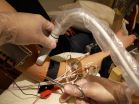(Press-News.org) Johns Hopkins and other cancer researchers report that a very short course of a chemotherapy drug, called cyclophosphamide, not only can prevent a life-threatening immune response in some bone marrow transplant recipients, but also can eliminate such patients' need for the usual six months of immune suppression medicines commonly prescribed to prevent severe forms of this immune response. Patients receive cyclophosphamide for two days after their bone marrow transplant, in addition to two other chemotherapy drugs given before the transplant.
Johns Hopkins Kimmel Cancer Center scientists first used cyclophosphamide to prevent severe graft-versus-host disease (GVHD) after bone marrow transplant involving haploidentical or "half-matched" transplants, a treatment first used in 2000 at the Cancer Center to treat leukemias and other blood cancers. The scientists began to use post-transplant cyclophosphamide in clinical trials of fully matched bone marrow transplants in 2004.
Now, the new multi-center study confirms that the post-transplant cyclophosphamide is safe and effective for people who have received fully-matched bone marrow transplants.
The shortened regimen, described online Sept. 29 in the Journal of Clinical Oncology, begins with intravenous busulfan and fludarabine, two chemotherapeutic drugs that wipe out a patient's immune system and prepare his or her body to receive donated marrow. After the transplant, patients receive two days of cyclophosphamide to prevent GVHD and rejection of the new bone marrow. Conventionally, most transplant patients get six months of immunosuppressive treatment for that purpose.
The bookended pre- and post-transplant treatments, which have been tested separately in other studies, already had promising track records in controlling cancer and preventing severe GVHD. Those successes led researchers from three hospitals, including Johns Hopkins, to combine the two therapies, says Leo Luznik, M.D., an associate professor of oncology at the Johns Hopkins University School of Medicine and leader of the study.
The new study enrolled 92 patients with high-risk blood cancers. Forty-five of the 92 patients received matched transplants from relatives, while 47 received matched transplants from unrelated donors.
After their transplants, 51 percent of the patients experienced grades II to IV acute GVHD, the milder form, and 15 percent of the patients experienced the severe forms of acute GVHD (grades III to IV). Only 14 percent of the patients developed chronic GVHD. A leading cause of post-bone marrow transplant deaths, chronic GVHD affects approximately one-half of patients who receive conventional treatments.
Two years after their transplants, 67 percent of patients were living, and 62 percent of all patients were cancer-free.
Luznik says he was encouraged by the low rate of chronic GVHD seen with the regimen, noting that the percentages of acute GVHD cases are similar to those seen with the standard six-month regimen of immunosuppressive drugs. Reducing the post-transplantation treatment to two days with cyclophosphamide, he explains, "also allows for the earlier integration of other treatments."
For example, immunotherapies used to eradicate any remaining cancer could be started much sooner under this regimen, says Christopher Kanakry, M.D, a Kimmel Cancer Center researcher and co-first author of the study. "If you give patients immune cells to eradicate any remaining cancer cells that might be present," he says, "those immune cells would not be prevented from doing their job by ongoing immune suppression drugs that are being used in patients treated with conventional transplant approaches."
Luznik says that the researchers' next step will be to test the short course therapy in a phase III randomized clinical trial that would directly compare results in patients who receive the cyclophosphamide treatment with those who receive either a separate, experimental approach to prevent GVHD or the more traditional six-month immunosuppressive therapy.
INFORMATION:
Other researchers on the study include Richard J. Jones of the Johns Hopkins Kimmel Cancer Center; Paul V. O'Donnell (co-first author), Terry Furlong and Marco Mielcarek of the Fred Hutchinson Cancer Research Center; and Marcos J. de Lima, Wei Wei, Richard E. Champlin, Peter F. Thall, and Borje S. Andersson of The University of Texas MD Anderson Cancer Center.
Funding for the study was provided by Otsuka Pharmaceutical.
Borje S. Andersson is a consultant/advisor at Otsuka and holds a patent related to material pertinent in this article: "Parenteral busulfan for the treatment of malignant disease," U.S. Patents No. 5430057 and 5559148, and Australia Patent No. 694141.
On the Web:
Read the study in the Journal of Clinical Oncology. http://jco.ascopubs.org/content/early/2014/09/29/JCO.2013.54.0625.full.pdf+html
Listen to a podcast discussing the study, produced by the Journal of Clinical Oncology. http://jco.ascopubs.org/content/early/2014/09/29/JCO.2013.54.0625/suppl/DC2
Media Contacts:
Vanessa Wasta, 410-614-2916, wasta@jhmi.edu
Amy Mone, 410-614-2915, amone@jhmi.edu
Johns Hopkins Medicine (JHM), headquartered in Baltimore, Maryland, is a $7 billion integrated global health enterprise and one of the leading academic health care systems in the United States. JHM unites physicians and scientists of the Johns Hopkins University School of Medicine with the organizations, health professionals and facilities of The Johns Hopkins Hospital and Health System. JHM's vision, "Together, we will deliver the promise of medicine," is supported by its mission to improve the health of the community and the world by setting the standard of excellence in medical education, research and clinical care. Diverse and inclusive, JHM educates medical students, scientists, health care professionals and the public; conducts biomedical research; and provides patient-centered medicine to prevent, diagnose and treat human illness. JHM operates six academic and community hospitals, four suburban health care and surgery centers, and more than 35 Johns Hopkins Community Physicians sites. The Johns Hopkins Hospital, opened in 1889, has been ranked number one in the nation by U.S. News & World Report for 22 years of the survey's 25 year history, most recently in 2013. For more information about Johns Hopkins Medicine, its research, education and clinical programs, and for the latest health, science and research news, visit http://www.hopkinsmedicine.org.
The spread of diseases from land animals to sea otters and other marine mammals is aided and abetted by gelatinous, sticky polymers produced by seaweed, reports a research team headed by a UC Davis veterinary infectious-disease expert.
These large, complex molecules form slimy biofilms and bind water-borne organic matter into larger particles, in which disease-causing microorganisms can become embedded and introduced to the marine food chain, the researchers discovered.
Using the parasite Toxoplasma gondii as a model, they showed how these sticky polymers increase the ...
Rochester, MN, October 7, 2014 – Numerous randomized clinical trials have shown the effectiveness of the two major forms of smoking cessation treatment – behavioral support and medication - in helping smokers quit. Researchers have now demonstrated that this approach can successfully translate to the "real world" and that a combination of the two treatments offers almost a threefold chance of success over attempts to quit without using a cessation aid. Their findings are published in Mayo Clinic Proceedings.
"Randomized clinical trials have a high internal ...
There is evidence that hunter-gatherers are optimal foragers whose behaviour is influenced by costs associated with foraging, and therefore for example rising the costs of ammunition could potentially help conserving wild animals. However, there has been a paucity of studies on whether the behaviour of bushmeat hunters, like that of consumers, is cost sensitive moneywise.
In Ecuador, ammunition prices rose unexpectedly by 300 per cent in early 2009, because of a tax imposed by the national Government. This happened right when Anders Sirén, then postdoc researcher ...
Adolescence is often a turbulent time, and it is marked by substantially increased rates of depressive symptoms, especially among girls. New research indicates that this gender difference may be the result of girls' greater exposure to stressful interpersonal events, making them more likely to ruminate, and contributing to their risk of depression.
The findings are published in Clinical Psychological Science, a journal of the Association for Psychological Science.
"These findings draw our focus to the important role of stress as a potential causal factor in the development ...
The human and environmental dangers posed by a widely used manufacturing technique could be almost eradicated thanks to research led by Plymouth University.
Fibre-reinforced polymer matrix composites are painted or sprayed onto products to provide a high-quality finish in transport applications, chemical plants, renewable energy systems and pipelines.
But that finishing process causes the vapours of a volatile organic compound – styrene, found in polyesters and vinyl-esters – to be emitted, posing potential health and wellbeing risks to the workforces involved ...
Scientists from the University of Leeds have taken a crucial step forward in bio-nanotechnology, a field that uses biology to develop new tools for science, technology and medicine.
The new study, published in print today in the journal Nano Letters, demonstrates how stable 'lipid membranes' – the thin 'skin' that surrounds all biological cells – can be applied to synthetic surfaces.
Importantly, the new technique can use these lipid membranes to 'draw' – akin to using them like a biological ink – with a resolution of 6 nanometres (6 billionths ...
VIDEO:
The Arctic and the Antarctic are regions that have a lot of ice and acts as air conditioners for the Earth system. This year, Antarctic sea ice reached a record...
Click here for more information.
Sea ice surrounding Antarctica reached a new record high extent this year, covering more of the southern oceans than it has since scientists began a long-term satellite record to map sea ice extent in the late 1970s. The upward trend in the Antarctic, however, is only about ...
Stretch sensors in our muscles participate in reflexes that serve the subconscious control of posture and movement. According to a new study published in the Journal of Neuroscience, these sensors respond weakly to muscle stretch caused by one's voluntary action, and most strongly to stretch that is imposed by external forces. The ability to reflect causality in this manner can facilitate appropriate reflex control and accurate self-perception.
"The results of the study show that stretch receptors in our muscles indicate more than which limb is moving or how fast; these ...
Just like adjusting a watch, the key to accurately telling evolutionary time is based upon periodically calibrating against a gold standard.
Scientists have long used DNA data to develop molecular clocks that measure the rate at which DNA changes, i.e., accumulates mutations, as a premiere tool to peer into the past evolutionary timelines for the lineage of a given species. In human evolution, for example, molecular clocks, when combined with fossil evidence, have helped trace the time of the last common ancestor of chimpanzees and humans to 5-7 million years ago, and ...
During cell division, chromosomes acquire a characteristic X-shape with the two DNA molecules (sister chromatids) linked at a central "connection region" that contains highly compacted DNA. It was unknown if rearrangements in this typical X-shape architecture could disrupt the correct separation of chromosomes. A recent study by Raquel Oliveira, from the Instituto Gulbenkian de Ciência (Portugal), in collaboration with colleagues from the University of California, Santa Cruz (USA), now shows that the dislocation of particular DNA segments perturbs proper chromosome ...



